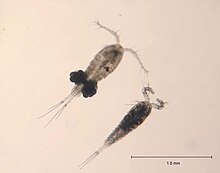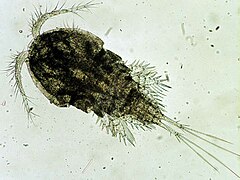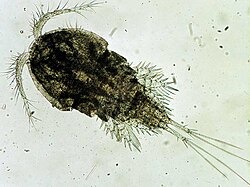pt-BR
nomes no trilho de navegação


Cyclops (dříve též Monoculus či Nauplius) je rod drobných vodních korýšů, řadící se mezi buchanky (Cyclopoida). Rod popsal již v roce 1776 dánský přírodovědec Otto Friedrich Müller.[1] Název se odvozuje od jednookých antických obrů, kyklopů.[2] Rod zahrnuje více než 400 druhů.
Buchanky dorůstají velikosti 0,5 až 5 mm. Mají 5 párů nohou, nepárové naupliové oko. Pětičlenný zadeček je zakončen vidlicovitým přívěškem se štětinami – furkou.
Buchanky jsou kosmopolitní.
Jsou hostiteli škulovců a vlasovce medinského. Spolu s dalšími drobnými korýši perloočkami jsou v akvaristice využívány jako krmivo – tzv. vodní blechy.
Tento článek je příliš stručný nebo postrádá důležité informace.Cyclops (dříve též Monoculus či Nauplius) je rod drobných vodních korýšů, řadící se mezi buchanky (Cyclopoida). Rod popsal již v roce 1776 dánský přírodovědec Otto Friedrich Müller. Název se odvozuje od jednookých antických obrů, kyklopů. Rod zahrnuje více než 400 druhů.
Cyclopser er små, ferskvands- og brakvandslevende vandlopper (krebsdyr) med en T-formet krop, der gør dem lette at genkende. Cyclopser er mellem 0,5 og 3 mm lange. De har en oval krop med et pandeøje og to vinkelret udstående, ugrenede antenner. Bagkroppen er meget smal. En hun har ofte to frithængende ægsække. Arterne er dog svære at kende forskel på, og det skyldes, at de stort set er ens i hovedtrækkene og kun afviger i små detaljer.
Cyclopser lever i stillestående vande, dvs. mest i ferskvand, men nogle arter lever også i brakvand. Udviklingen fra æg til kønsmoden voksen går over i alt 13 stadier, der er adskilt af hudskifter. Om sommeren klækkes æggene efter ca. en uge, mens det sidste efterårskuld ofte bæres gennem hele vinteren og først klækkes i det tidlige forår.
Wikimedia Commons har medier relateret til:Die Hüpferlinge (Cyclops) sind eine Gattung der Ruderfußkrebse (Copepoda). Ihr wissenschaftlicher Name leitet sich von den Kyklopen (Zyklopen) ab, einäugigen Sagengestalten aus der griechischen Mythologie, denn auch Hüpferlinge haben nur ein einziges Auge, das in der Mitte liegende (mediane) Naupliusauge.
Die Hüpferlinge werden 0,5–1 mm lang. Sie gliedern sich deutlich in zwei Körperabschnitte. Das breit ovale Vorderteil setzt sich aus dem Kopf und den ersten fünf Brustsegmenten zusammen. Das Hinterteil ist deutlich schlanker. Es besteht aus dem schmalen sechsten Brust- und vier beinlosen Hinterleibssegmenten und trägt am Ende zwei Hinterleibsanhänge. Die langen ersten Antennen sind bei den kleineren Männchen zu Greiforganen umgebildet, mit denen die Weibchen bei der Paarung festgehalten werden. Die Weibchen heften ihre Eier nach dem Ablegen in zwei Säckchen am Körper fest.
Der Trivialname „Hüpferling“ ist auf die Fortbewegungsweise der Tiere zurückzuführen. Die ersten Antennen schlagen ruckartig nach hinten und lassen das Tier durch den Rückstoß nach vorne schnellen. Dann gleitet es wieder etwas zurück, um wieder nach vorne zu „hüpfen“.
Die Hüpferlinge leben von kleinen Pflanzenteilen, Tierchen oder Aas. Sie dienen auch selbst als Nahrung für Fischbrut und räuberische Insekten.
Die Hüpferlinge kommen weltweit im Süßwasser, seltener im Brackwasser vor. Sie leben in den Uferzonen pflanzenreicher stehender und schwach fließender Gewässer. In den stehenden Gewässern Mitteleuropas sind ca. 20 Arten vertreten. In ganz Europa kommen über 100, weltweit über 400 Arten vor.
Ungünstige Lebensbedingungen können sie in einem Schleimmantel überstehen, welcher von besonderen Hautdrüsen gebildet wird. Diese Zystenbildung ermöglicht das Besiedeln kleinerer Gewässer, die von regelmäßiger Austrocknung betroffen sind. Sogar in Fahrspuren und Baumlöchern kommen einige Hüpferlinge vor.
Auch kommen diese kleinen Tierchen in Aquarien vor. Sie werden meist mit Pflanzen eingeschleppt.
Hüpferlinge spielen in den Verbreitungsregionen des Medinawurms als Wirte für dessen Larven die entscheidende Rolle bei dessen Verbreitung und dem Entstehen der Drakunkulose beim Menschen, aber auch bei anderen Säugetieren, vor allem dem Haushund. Die wichtigste vorbeugende Maßnahme besteht im Filtern des Trinkwassers.
Die Hüpferlinge (Cyclops) sind eine Gattung der Ruderfußkrebse (Copepoda). Ihr wissenschaftlicher Name leitet sich von den Kyklopen (Zyklopen) ab, einäugigen Sagengestalten aus der griechischen Mythologie, denn auch Hüpferlinge haben nur ein einziges Auge, das in der Mitte liegende (mediane) Naupliusauge.
Ciklopët sikurse dafinat janë gaforre të vogla, të cilat kanë vetëm një sy. Këto gaforre shërbejnë si ushqim i mirë i peshqit.
![]() Ky artikull në lidhje me biologjinë është i cunguar. Ndihmoni dhe ju në përmirsimin e tij.
Ky artikull në lidhje me biologjinë është i cunguar. Ndihmoni dhe ju në përmirsimin e tij.
Cyclops is one of the most common genera of freshwater copepods, comprising over 400 species.[1][2] Together with other similar-sized non-copepod fresh-water crustaceans, especially cladocera, they are commonly called water fleas. The name Cyclops comes from the Cyclops of Greek mythology, as they have a single large eye; in Cyclops, the eye may be either red or black.

Cyclops individuals may range from ½–5 mm long[3] and are clearly divided into two sections. The broadly oval front section comprises the head and the first five thoracic segments. The hind part is considerably slimmer and is made up of the sixth thoracic segment and the four legless pleonic segments. Two caudal appendages project from the rear. Although they may be difficult to observe, Cyclops has 5 pairs of legs. The long first antennae, 2 in number, are used by the males for gripping the females during mating. Afterwards, the female carries the eggs in two small sacs on her body. The larvae, or nauplii, are free-swimming and unsegmented.
Cyclops has a cosmopolitan distribution in fresh water, but is less frequent in brackish water. It lives along the plant-covered banks of stagnant and slow-flowing bodies of water, where it feeds on small fragments of plant material, animals (such as nematodes), or carrion. It swims with characteristic jerky movements. Cyclops has the capacity to survive unsuitable conditions by forming a cloak of slime. Average lifespan is about 3 months.
Cyclops is intermediate host of dracunculiasis (guinea-worm disease) and fish tapeworm (Diphyllobothrium latum) infection. This disease can be passed to humans through drinking infected water. Dracunculiasis will rarely cause death but is a weakening disease.[4]
Cyclops can be controlled using physical, chemical, biological and engineering methods.
Straining of water through piece of fine cloth is sufficient to remove Cyclops. It can also be killed by boiling water, as it is easily killed by heat at 60 °C.
Chlorine in strength of 22 ppm destroys Cyclops in 2 hours;[5] although this concentration of chlorine gives bad odour and taste to water. Excess chlorine can be removed with Sodium thiosulfate. Calcium hydroxide at dosage of 4 gram per gallon of water can be used. Temefos kills cyclops at concentration of 1 mg/litre.
Small fish like barbel and Gambusia feed on Cyclops. This type of predation was used in Indian state of Karnataka to eradicate dracunculiasis.[6]
Provision of drinking water through piping water supply, use of tubewells and abolition of stepwells are effective measures on community level.[7]
 Female and male Cyclops bicuspidatus, the dominant cyclopoid species in Lake Michigan
Female and male Cyclops bicuspidatus, the dominant cyclopoid species in Lake Michigan Cyclops is one of the most common genera of freshwater copepods, comprising over 400 species. Together with other similar-sized non-copepod fresh-water crustaceans, especially cladocera, they are commonly called water fleas. The name Cyclops comes from the Cyclops of Greek mythology, as they have a single large eye; in Cyclops, the eye may be either red or black.
 Nauplius larva of Cyclops
Nauplius larva of Cyclops
Cyclops est un des genres les plus communs de la sous-classe des copépodes, crustacés aquatiques de petite taille. Ce genre comprend plus de 100 espèces, vivant toutes en eau douce. Le nom de ce genre vient du mot Cyclops, le cyclope de la mythologie grecque, car les espèces de ce genre ne possèdent qu'un œil médian.
Les Cyclops ont une longueur qui varie de 0,5 à 5 mm. Le corps est clairement divisé en deux zones : la partie antérieure, de forme ovale, est constituée par la tête et les cinq premiers segments thoraciques. La partie postérieure, beaucoup plus mince, est constituée du sixième segment thoracique et des quatre segments abdominaux, prolongés par deux appendices caudaux. Les Cyclops ont cinq paires de pattes, même si elles ne sont pas toujours très visibles.
Leur natation est saccadée[1].
Les Cyclops se nourrissent de protozoaires (paramécies par exemple) et de petits crustacés (daphnies)[2], mais aussi de débris animaux et végétaux.
La première paire d'antennes, assez longue, est utilisée par le mâle pour agripper la femelle pendant l'accouplement. Les femelles portent les œufs dans deux petits sacs accrochés à leur corps. Les larves, de type nauplius, sont nageuses.
Le genre Cyclops est très cosmopolite en eau douce, et moins fréquent en eau saumâtre. Ces espèces vivent dans les plans d'eau stagnants ou à courant faible, près des rives couvertes de végétation généralement.
Les Cyclops servent de nourriture à un grand nombre d'animaux, comme les poissons et les alevins. Il s'agit d'une source de nourriture d'autant plus importante que leur reproduction est rapide. Ils sont de fait un élément important des réseaux alimentaires aquatiques[2].
Les Cyclops sont impliqués dans certaines parasitoses en tant qu'hôte intermédiaire, c'est-à-dire qu'ils hébergent la forme larvaire (métazoaires) ou la forme asexuée (protozoaires) du parasite :
Dans ces deux cas ils hébergent la forme larvaire du parasite (microfilaire pour Dracunculus medinensis et Coracidium, puis larve procercoïde pour les Diphyllobothrium). C'est ainsi qu'il contamine l'homme qui l'ingère en buvant de l'eau (cas de la filaire de Médine) ou en mangeant un poisson l'ayant lui-même précédemment ingéré (cas des Diphyllobothrium où le poisson joue dans ce cas le rôle de second hôte intermédiaire puisque la larve y subit de nouveau une différenciation).
Selon ITIS (25 mars 2012)[4] :
Cyclops est un des genres les plus communs de la sous-classe des copépodes, crustacés aquatiques de petite taille. Ce genre comprend plus de 100 espèces, vivant toutes en eau douce. Le nom de ce genre vient du mot Cyclops, le cyclope de la mythologie grecque, car les espèces de ce genre ne possèdent qu'un œil médian.
Cyclops è un genere di copepodi della famiglia Cyclopidae.
Sheldon J. Plankton, personaggio della serie animata SpongeBob, è un Cyclops.
Cyclops è un genere di copepodi della famiglia Cyclopidae.
Cyclops is een geslacht van eenoogkreeftjes uit de familie van de Cyclopidae.
Cyclops is een geslacht van eenoogkreeftjes uit de familie van de Cyclopidae.
Cyclops er en utbredt gruppe hoppekreps. Navnet kommer fra kyklopene i gresk mytologi, og de deler den egenskapen at de bare har ett enkelt, stort øye.
Cyclops kan bli fra ½–5 mm lange, og er tydelig delt i to seksjoner. Den brede, ovale fremdelen består av hodet og de første fem thorax-segmentene. Bakdelen er betydelig slankere og består av det sjette thorax-segmentet og de fire fotløse pleoniske segmentene. Cyclops finnes over hele verden i ferskvann, men er mindre utbredt i brakkvann. De lever langs plantedekkede bredder i stillestående og sakteflytende vannmasser, hvor de eter små fragmenter av plantemateriale, dyr og annet.
Cyclops er en utbredt gruppe hoppekreps. Navnet kommer fra kyklopene i gresk mytologi, og de deler den egenskapen at de bare har ett enkelt, stort øye.
Cyclops kan bli fra ½–5 mm lange, og er tydelig delt i to seksjoner. Den brede, ovale fremdelen består av hodet og de første fem thorax-segmentene. Bakdelen er betydelig slankere og består av det sjette thorax-segmentet og de fire fotløse pleoniske segmentene. Cyclops finnes over hele verden i ferskvann, men er mindre utbredt i brakkvann. De lever langs plantedekkede bredder i stillestående og sakteflytende vannmasser, hvor de eter små fragmenter av plantemateriale, dyr og annet.

Oczlik (Cyclops) – rodzaj skorupiaków z rodziny Cyclopidae.
Nazwa ich pochodzi od mitycznego Cyklopa, ponieważ posiadają one jedno duże oko. Ciało długości od 0,5 do 5 mm składa się z głowotułowia i segmentowanego odwłoka. Na głowie posiada oko naupliusowe i 2 pary czułków 8-17 członowe, które są narządem ruchu. Poruszają się skokowo poprzez uderzenia czułków, nie posiadają serca. Na tułowiu występuje 5 par dwu gałęziastych odnóży zakończonych szczecinkami. Odwłok kończy się widełkami. Samice noszą dwa pakiety jaj umieszczone w symetrycznie położonych workach. Oczliki występują w dużych ilościach w planktonie, są pokarmem dla ryb (głównie narybku). Preferują wody stojące, płycizny przy brzegach rzek, zarośnięte zbiorniki wodne, można je licznie spotkać nawet w długo niewysychających kałużach, mogą przetrwać suszę co sprzyja dużym możliwościom rozprzestrzeniania.
Większa część oczlików są to formy żyjące wolno, ale pojedyncze gatunki są półpasożytami lub pasożytami np. ergazyloza. Żywią się resztkami roślin, mniejszymi organizmami, oraz padliną, bywa że ich pokarmem jest tkanka przyranna na ciałach większych zwierząt.
Występuje w planktonie pod samą powierzchnią wody. W polskich wodach słodkich powszechnie występują Cyclops strenuus i Cyclops abyssorum.
W akwarystyce wykorzystywane jako pokarm dla ryb (żywe lub mrożone).
Oczlik (Cyclops) – rodzaj skorupiaków z rodziny Cyclopidae.
Nazwa ich pochodzi od mitycznego Cyklopa, ponieważ posiadają one jedno duże oko. Ciało długości od 0,5 do 5 mm składa się z głowotułowia i segmentowanego odwłoka. Na głowie posiada oko naupliusowe i 2 pary czułków 8-17 członowe, które są narządem ruchu. Poruszają się skokowo poprzez uderzenia czułków, nie posiadają serca. Na tułowiu występuje 5 par dwu gałęziastych odnóży zakończonych szczecinkami. Odwłok kończy się widełkami. Samice noszą dwa pakiety jaj umieszczone w symetrycznie położonych workach. Oczliki występują w dużych ilościach w planktonie, są pokarmem dla ryb (głównie narybku). Preferują wody stojące, płycizny przy brzegach rzek, zarośnięte zbiorniki wodne, można je licznie spotkać nawet w długo niewysychających kałużach, mogą przetrwać suszę co sprzyja dużym możliwościom rozprzestrzeniania.
Większa część oczlików są to formy żyjące wolno, ale pojedyncze gatunki są półpasożytami lub pasożytami np. ergazyloza. Żywią się resztkami roślin, mniejszymi organizmami, oraz padliną, bywa że ich pokarmem jest tkanka przyranna na ciałach większych zwierząt.
Występuje w planktonie pod samą powierzchnią wody. W polskich wodach słodkich powszechnie występują Cyclops strenuus i Cyclops abyssorum.
W akwarystyce wykorzystywane jako pokarm dla ryb (żywe lub mrożone).
Metne bakınız.
SinonimlerMonoculus Linnaeus, 1758
Nauplius Müller, 1785
Cyclops , Copepoda alt sınıfından kozmopolit bir kabuklu cinsi. Yaklaşık 400 kadar türü bulunur.
Geniş ve uzun yapılı küçük planktonik hayvanlardır. Boyu 0,5–5 mm uzunluğundadır. Familyanın en iri cinslerinden biridir. Erkekler, uzun olan birincil duyargalarını çiftleşme sırasında dişileri tutmak için kullanırlar. Dişiler, yumurtalarını iki yanda da bulunan keseciklerde taşırlar. Larvalarına nauplius adı verilir.
Adı, Yunan mitolojisindeki, alnının ortasında tek bir gözü bulunan Kiklop'dan esinlenerek konmuştur.
Tatlı su kürekayaklılarının (kopepodlarının) en yaygını ve en tanınmış cinsidir. Kozmopolit olduğu için bütün dünyada görülür.
Cyclops , Copepoda alt sınıfından kozmopolit bir kabuklu cinsi. Yaklaşık 400 kadar türü bulunur.

ケンミジンコ(剣微塵子)は、節足動物門甲殻綱カイアシ亜綱に属する動物のうち、キクロプス属Cyclopus のもの、またはキクロプス目 Cyclopoida に属するもの、さらに広義にはカイアシ類の別称である。
甲殻綱カイアシ亜綱には11の目があるが、ケンミジンコに類するものはカラヌス目(ヒゲナガケンミジンコ目)Calanoida、キクロプス目(ケンミジンコ目)Cyclopoida とハルパクチクス目(ソコミジンコ目)Harpacticoida のものである。
多くはプランクトンとして水中を浮遊する微小な甲殻類である。底生のもの、寄生性のもの、陸生のものも存在する。Cyclopsはギリシア神話に登場する一つ目の巨人のことで、ケンミジンコの目が一つであることからこの名がつけられた(ただしミジンコにも目は一つしかない)。
マンソン孤虫の中間宿主[1]で有るため、「ケンミジンコを餌として捕食している魚類を生や加熱不十分な状態で食べる」や「生山水(非加熱)の飲水」などにより、寄生虫症を発症することがある。
ケンミジンコ(剣微塵子)は、節足動物門甲殻綱カイアシ亜綱に属する動物のうち、キクロプス属Cyclopus のもの、またはキクロプス目 Cyclopoida に属するもの、さらに広義にはカイアシ類の別称である。
참검물벼룩속(Cyclops)은 검물벼룩목에 속하는 속 분류군이다. 연못 등의 담수에서 서식한다.
기생충인 스피로메트라 촌충와 메디나충의 중간 숙주이다.[1] 이로 인해 해당 생물을 먹은 고기를 가열하지 않고 먹거나, 물을 가열하지 않고 마셨을 때 발병할 수 있다.